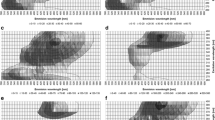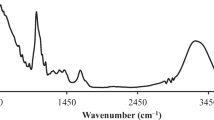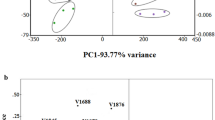Abstract
Sidr honey from Ziziphus species is gaining importance after Manuka honey due to its health benefits, therefore chemical fingerprinting of the Sidr honey from different regions of Pakistan was performed in comparison with other unifloral (Elettaria cardamomum, Citrus reticulata and Grewia asiatica) and polyfloral honey. Front face, synchronous fluorescence spectroscopy (SFS) was recorded at an excitation wavelength range from 250–450 nm with offset of 60 nm. All honey samples have fluorescent emission peaks at 342 and 349 nm attributed to amino acid (Tryptophan). The emission spectra of raw Sidr honey showed clear discrimination from uni/polyfloral and commercial samples owing to its phenolic profile with peaks at 396 and major distinctive peak at 451 nm that corresponds to caffeic acid, chlorogenic acid and ferulic acid. Whereas a year old Sidr honey showed decreased and shifted fluorescence emission from amino acid and phenolic compounds respectively. Variation in fluorescent intensity of phenolic compounds in Sidr honey from different regions of Pakistan may be attributed to diverse species of Ziziphus in these geographical areas. A broad band from 395 to 459 nm in commercial honey samples are due to fluorescence of Maillard reaction products that could be generated during thermal processing of honey. Natural variability exists among honey samples owing to different floral origin as authenticated by Principal Component and Heirarchial Cluster Analysis techniques applied in this study. The unique fluorescence emission spectra of raw Sidr honey samples proposed front face SFS as a simple technique for the quick identification of its monofloral origin. Therefore, fluorescent inherent markers are helpful in identifying botanical and geographical origin and may also be standardized to authenticate the purity of honey.







Similar content being viewed by others
References
Visweswara P, Thevan K, Salleh N, Hua S (2016) Biological and therapeutic effects of honey produced by honey bees and stingless bees: a comparative review. Rev Brasil Farmacogn 26:657–664
Bong J, Loomes KM, Schlothauer RC, Stephens JM (2016) Fluorescence markers in some New Zealand honeys. Food Chem 192:1006–1014. https://doi.org/10.1016/j.foodchem.2015.07.118
Istasse T, Jacquet N, Berchem T et al (2016) Extraction of honey polyphenols: method development and evidence of Cis isomerization. AnAlyticAl Chem Insights 2016:49–57. https://doi.org/10.4137/ACI.S39739.TYPE
Aparna AR, Rajalakshmi D (1999) Honey—its characteristics, sensory aspects, and applications. Food Rev Int 15:455–471
Özbalci B, Boyaci IH, Topcu A et al (2013) Rapid analysis of sugars in honey by processing Raman spectrum using chemometric methods and artificial neural networks. Food Chem 136:1444–1452. https://doi.org/10.1016/j.foodchem.2012.09.064
Andrade P, Ferreres F, Teresa Amaral M (1997) Analysis of honey phenolic acids by HPLC, its application to honey botanical characterization. J Liq Chromatogr Relat Technol 20:2281–2288. https://doi.org/10.1080/10826079708006563
Lenhardt L, Bro R, Zekovic I, Dramicanin T, Dramicanin MD (2015) Fluorescence spectroscopy coupled with PARAFAC and PLSDA for characterization and classification of honey. Food Chem 175:284–291
Karoui R, Dufour E, Bosset JO, De Baerdemaeker J (2006) The use of front face fluorescence spectroscopy to classify the botanical origin of honey samples produced in Switzerland. Food Chem 101:314–323. https://doi.org/10.1016/j.foodchem.2006.01.039
Ghosh N, Verma Y, Majumder SK, Gupta PK (2005) A fluorescence spectroscopic study of honey and cane sugar syrup. Food Sci Technol Res 11:59–62
Ghramh HA, Ibrahim EH (2020) Study of anticancer, antimicrobial, immunomodulatory, and silver nanoparticles production by Sidr honey from three different sources. Food Sci Nutr 8:445–455. https://doi.org/10.1002/fsn3.1328
Golmohammadi F (2013) Medicinal plant of Jujube (Ziziphus jujuba) and its indigenous knowledge and economic importance in desert regions in east of Iran : situation and problems. Tech J Eng Appl Sci 3:493–505
Pawlowska AM, Camangi F, Bader A, Braca A (2009) Flavonoids of Zizyphus jujuba L. and Zizyphus spina-christi (L.) Willd (Rhamnaceae) fruits. Food Chem 112:858–862
Hasan NM, AlSorkhy MA, Al Battah FF (2014) Ziziphus jujube (Ennab) of the Middle East. Food Med 2:7–11
Gao QH, Wu CS, Wang M (2013) The Jujube (Ziziphus Jujuba Mill) fruit: a review of current knowledge of fruit composition and health benefits. J Agric Food Chem 61:3351–3363
Wikipedia: https://www.enwikipediaorg/wiki/Ziziphus. Accessed Apr 2019
eFlora: https://www.efloras,org/florataxon,aspx?flora_id=5&taxon_id=135333. Accessed May 2019
Perveen A, Qaiser M (2005) Pollen flora of Pakistan. Paskistan J Bot 37:195–202
https://www.thethirdpole.net/2020/04/03/climate-change-deforestation-cripple-pakistans-honey-exports/. Accessed May 2020
Dhakku NA (2012) DAWN NEWS Beekeeping industry needs govt patronage. https://www.dawncom/news/765003. Accessed 18 Nov 2012
https://balqees.com/differences-in-sidr-honeys. Accessed Apr 2019
Corvucci F, Nobili L, Melucci D, Grillenzoni FV (2015) The discrimination of honey origin using melissopalynology and Raman spectroscopy techniques coupled with multivariate analysis. Food Chem 169:297–304. https://doi.org/10.1016/j.foodchem.2014.07.122
Dufour E, Riaublanc A (1997) Potentiality of spectroscopic methods for the characterization of dairy products I Front-face fluorescence study of raw heated and homogenised milks. Le Lait INRA Editions 77:657–670
Herbert S, Riou NM, Devaux MF et al (2000) Monitoring the identity and the structure of soft cheeses by fluorescence spectroscopy. Lait 80:621–634. https://doi.org/10.1051/lait:2000149
Mazerolles G, Devaux M, Duboz G, Duployer MH, Mouhous RN, Dufour E (2001) Infrared and fluorescence spectroscopy for monitoring protein structure and interaction changes during cheese ripening. LAIT 81:509–527
Aitkenhead C, Rosendale D, Schlothauer RC, Stephens JMC (2014) Method and apparatus that utilises fluorescence to determine plant or botanical origin characteristics of honey. Patent No US 8759774 B2
Ruoff K, Karoui R, Dufour E, Luginbühl W, Bosset JO, Bogdanov S, Amadò R (2005) Authentication of the botanical origin of honey by front—face fluorescence spectroscopy. A preliminary study. J Agric Food Chem 53:1343–1347
Ruoff K, Lüginbuhl W, Künzli R, Bogdanov S, Bosset JO, von der Ohe K et al (2006) Authentication of the botanical and geographical origin of honey by front-face fluorescence spectroscopy. J Agric Food Chem 54:6858–6866
Sergiel I, Pohl P, Biesaga M, Mironczyk A (2013) Suitability of three-dimensional synchronous fluorescence spectroscopy for fingerprint analysis of honey samples with reference to their phenolic profiles. Food Chem. https://doi.org/10.1016/j.foodchem.2013.08.069
Karoui R, Bosset JO, Mazerolles G, Kulmyrzaev A, Dufour E (2005) Monitoring the geographic origin of both experimental French Jura hard cheeses and Swiss Gruyere and L’Etivaz PDO cheeses using mid-infrared and fluorescence spectroscopies: a preliminary investigation. Int Dairy J 15:275–286
Pacheco ME, Bruzzone L (2013) Synchronous fluorescence spectrometry: conformational investigation or inner filter effect ? J Lumin 137:138–142. https://doi.org/10.1016/j.jlumin.2012.12.056
Lin B, Loomes K, Prijic G, Schlothauer R, Jonathan MS (2017) Lepteridine as a unique fluorescent marker for the authentication of manuka honey. Food Chem 225:175–180. https://doi.org/10.1016/j.foodchem.2016.12.099
Roshan A, Gad HA, El-ahmady S, Aboushoer M (2013) Authentication of the monofloral Yemeni Sidr honey using UV spectroscopy and chemometric analysis. J Agric Food Chem 1461:7722–7729. https://doi.org/10.1021/jf402280y
Martins SIFS, Jongen WMF, Van Boekel MAJS (2000) A review of Maillard reaction in food and implications to kinetic modelling. Trends Food Sci Technol 11:364–373. https://doi.org/10.1016/S0924-2244(01)00022-X
Tornuk F, Karaman S, Ozturk I, Toker OS, Tastemur B, Sagdic O et al (2013) Quality characterization of artisanal and retail Turkish blossom honeys: determination of physicochemical, microbiological, bioactive properties and aroma profile. Ind Crops Prod 46:124–131
Arribas LG, Morales FJ (2010) Estimation of dietary intake of 5-hydroxymethylfurfural and related substances from coffee to Spanish population. Food Chem Toxicol 48:644–649
Missio P, Gauche C, Gonzaga LV et al (2016) Honey: chemical composition, stability and authenticity. Food Chem 196:309. https://doi.org/10.1016/j.foodchem.2015.09.051
Lang M, Stober F, Uchtenthaler HK (1991) Fluorescence emission spectra of plant leaves and plant constituents Rad Environ. Biophysics 30:333–347
Beretta G, Granata P, Ferrero M, Orioli M, Facino RM (2005) Standardization of antioxidant properties of honey by a combination of spectrophotometric/fluorimetric assays and chemometrics. Anal Chim Acta 533:185–191
Bertoncelj J, Dobersek U, Jamnik M, Golob T (2007) Evaluation of the phenolic content antioxidant activity and colour of slovenian honey. Food Chem 105:822–828
Meda A, Lamien CE, Romito M, Millogo J, Nacoulma OG (2005) Determination of the total phenolic flavonoid and proline contents in Burkina Fasan honey as well as their radical scavenging activity. Food Chem 91:571–577
Peng S, Ling N, Aniza Y et al (2014) Total Phenolic contents and colour intensity of Malaysian honeys from the Apis spp. and Trigona spp. Bees Ital Oral Surg 2:150–155. https://doi.org/10.1016/j.aaspro.2014.11.022
Acknowledgements
The authors are thankful to Mrs. Fatima Batool (Scientific Assistance II), NILOP for her help in conducting experiment.
Author information
Authors and Affiliations
Corresponding author
Ethics declarations
Conflict of interest
The authors declare that they have no conflict of interest.
Compliance with ethics requirements
This article does not contain any studies with human participants performed by any of the authors.
Additional information
Publisher's Note
Springer Nature remains neutral with regard to jurisdictional claims in published maps and institutional affiliations.
Rights and permissions
About this article
Cite this article
Ali, H., Khan, S., Ullah, R. et al. Fluorescence fingerprints of Sidr honey in comparison with uni/polyfloral honey samples. Eur Food Res Technol 246, 1829–1837 (2020). https://doi.org/10.1007/s00217-020-03536-6
Received:
Revised:
Accepted:
Published:
Issue Date:
DOI: https://doi.org/10.1007/s00217-020-03536-6




